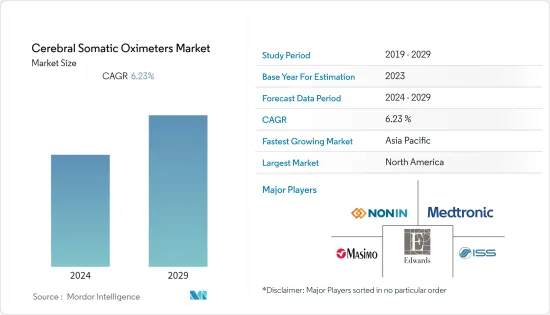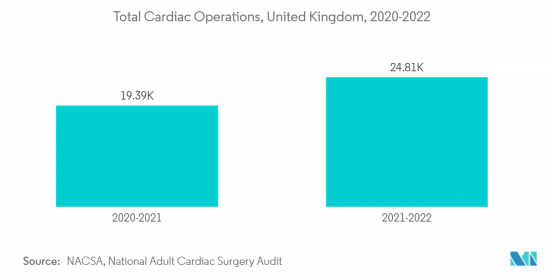
|
市場調査レポート
商品コード
1405690
脳体部オキシメータ:市場シェア分析、産業動向と統計、成長予測、2024~2029年Cerebral Somatic Oximeters - Market Share Analysis, Industry Trends & Statistics, Growth Forecasts 2024 - 2029 |
||||||
カスタマイズ可能
適宜更新あり
|
|||||||
| 脳体部オキシメータ:市場シェア分析、産業動向と統計、成長予測、2024~2029年 |
|
出版日: 2024年01月04日
発行: Mordor Intelligence
ページ情報: 英文 111 Pages
納期: 2~3営業日
|
全表示
- 概要
- 目次
脳体部オキシメータ市場規模は2024年の1億9,121万米ドルから2029年には2億4,351万米ドルに成長し、予測期間(2024-2029年)のCAGRは6.23%と予測されます。

主なハイライト
- 脳体部オキシメータ市場はCOVID-19パンデミックの影響を大きく受けました。パンデミックの発生以来、特に発展途上国では医療機器のサプライチェーンの混乱とともに、多くの国々で選択手術が延期またはキャンセルされました。例えば、2022年5月にBrazilian Journal of Cardiovascular Surgeryに掲載された論文によると、エジプトのMain University Hospitalの病院スタッフは、心臓外科外来からの新規入院を延期し、パンデミック期間中は現在入院中の患者および緊急患者に限定して手術を行うよう指示されたといいます。しかし、この2年間、世界各地で必要でない医療処置が徐々に再開されたため、市場は回復し始めました。
- 脳体部オキシメータ市場は予測期間中に健全な成長が見込まれます。この成長の主な要因は、神経疾患の罹患率の上昇と、北米や欧州などの新興経済諸国における脳用オキシメータの採用拡大です。
- 2022年4月に国立生物工学情報センター(NCBI)に掲載された論文によると、低酸素性虚血性脳症(HIE)は先進国では出生1000人当たり1~6人、新興諸国では出生1000人当たり26人で報告されています。このような神経疾患の負担が大きいことから、脳内の酸素濃度を検出する脳体部オキシメーターの需要が高まり、市場の成長を後押ししています。
- さらに、脳オキシメトリは一部の新生児集中治療室(NICU)で日常的に使用されています。例えば、2022年4月にFrontiers in Pediatrics Journalに掲載された論文によると、脳オキシメトリは心臓手術の文脈で利用されており、先天性心疾患を持つ新生児や新生児科の周術期ケアにおける臨床ルーチンとしてほぼ普遍的に使用されています。論文によると、現在、新生児科の重症脳損傷における脳オキシメトリーの重要性を評価する臨床試験が進行中です。調査研究の増加は、予測期間中に様々な脳および心臓疾患の酸素レベルの検出における脳体内オキシメータの有用性を推進すると予想されます。
- さらに、製品の承認や発売につながる技術進歩などの市場プレイヤーの戦略的イニシアティブやパートナーシップも、予測期間中の市場成長に寄与しています。例えば、2021年12月、Medtronic PLCは、小児適応のINVOS 7100 cerebral/somatic oximetryシステムのFDA(食品医薬品局)510(k)承認を取得しました。INVOSシステムは、小児科の臨床医が新生児、未熟児、小児、その他の治療患者の人工呼吸、血行動態管理、蘇生に関して一刻を争う決断を下すのに役立ちます。したがって、小児人口向けの技術的に先進的な脳内オキシメータの発売は、予測期間中に顧客基盤を拡大し、脳内体細胞オキシメータ市場に成長をもたらすと予想されます。
- したがって、神経疾患の高い負担や技術的に高度な製品の承認などの前述の要因によって、脳体部オキシメータ市場は分析期間中に成長を示すと予想されます。しかし、脳体部オキシメータに使用される高価なセンサのために装置のコストが高いことが、市場の成長を抑制すると推定されます。
脳体部オキシメータ市場の動向
予測期間中、心臓外科手術が大きな市場シェアを占める見込み
- アプリケーション別では、心臓血管外科手術が予測期間中に脳体部オキシメータ市場で大きな市場シェアを占めると予測されます。大動脈手術、不整脈手術、子宮筋腫摘出術、冠動脈バイパス移植(CABG)手術におけるこれらのデバイスの需要の増加は、合併症のリスクを最小限に抑え、吻合漏れを減少させる能力に起因しています。
- 脳オキシメータの成長の主な要因は、運動不足のデスクワーク中心のライフスタイル、適切な食生活の欠如、不安、ストレスによる慢性疾患であり、その結果、複数の心血管疾患(CVD)の蔓延につながっています。例えば、米国疾病予防管理センター(CDC)の全米健康統計センター(2022年更新)によると、米国では18歳以上の成人人口の1.5%で狭心症が報告されています。
- また、オーストラリア統計局の2022年3月最新版によると、オーストラリアにおける心臓病の有病率は4.0%で、2021年には100万人に達しました。狭心症、心筋梗塞、脳卒中などの心血管疾患は、女性よりも男性に多い(3.1%に対し4.9%)。このように、世界的に心血管疾患の負担が大きいことから、世界的にCABG手術の件数が多くなり、予測期間中のセグメント成長を促進すると予想されます。
- さらに、2021年12月にPLOS One Journalに掲載された調査論文によると、脳オキシメータは心臓手術中の脳酸素飽和度の変化や脳虚血を検出するために頻繁に使用されています。同出典によると、心臓の大手術を受けた患者の25%から80%が、研究期間中に術後神経認知障害(POND)を経験したといいます。心臓の大手術の際、脳オキシメーターの使用はPONDの発症を予測する上で極めて重要です。この研究では、心臓手術中の脳オキシメーター値の上昇もPONDの危険因子である可能性が示唆されました。したがって、調査研究における脳体部オキシメータの高い有用性は、心臓手術中の需要を促進し、セグメント成長を増強すると予測されます。
- したがって、世界中で実施される心臓手術の高い負担は、心臓手術における脳オキシメータの使用とともに、予測期間中のセグメントの成長に大きな影響を与えています。

北米が予測期間中に大きな市場シェアを占める見込み
- 北米は、神経疾患の罹患率の上昇、高齢者人口の増加、より良いヘルスケアインフラ、同地域における業界プレイヤーの強力なプレゼンスなどの要因により、大きな市場シェアを保持すると予測されています。
- Cedars-Sinaiが2022年1月に更新したデータによると、冠動脈バイパス手術(CABG)は、冠動脈バイパス手術またはバイパス手術としても知られ、最も一般的な心臓手術であり、米国では毎年30万人以上がバイパス手術に成功しています。このように、米国ではCABG手術の負担が大きいため、脳体部オキシメータの有用性が高く、また技術的に高度な製品を開発する機会も生まれ、このセグメントの成長を促進すると予想されます。
- さらに、アルツハイマー病協会によると、アルツハイマー病を患うアメリカ人の数は急速に増加しています。alzheimers.orgのデータによると、米国では2021年、65歳以上の米国人が620万人と推定され、アルツハイマー関連の認知症を患っているといいます。このように、この地域では神経疾患の負担が大きいため、脳の酸素レベルの検出に使用される脳体部オキシメーターの成長が見込まれ、市場成長を促進すると予測されています。
- また、米国国立衛生研究所(NIH)のEstimates of Funding for Various Research, Condition, and Disease Categories(RCDC), 2022 updateによると、米国における脳性麻痺の研究費は2021年に3,000万米ドルであり、2022年には3,200万米ドルになると推定されています。脳オキシメータは、ルーチンの酸素レベル検出のためにこれらの疾患で広く使用されています。疾患の研究への支出が多いことから、革新的な脳体性オキシメータの開発機会が創出され、予測期間中の同地域の市場成長を後押しすると期待されます。
- このように、上記のすべての要因のおかげで、調査された市場はこの地域で高い成長を示すことが期待されています。
脳体部オキシメータ産業の概要
脳体部オキシメータ市場は、少数の市場プレイヤーの存在により、適度に統合されています。大手企業は市場の特定分野で地位を確立しています。さらに、各社は新興地域で世界企業や既存のローカル企業と競合しています。主なプレーヤーは、既存製品に対抗するために新しい製品や技術を開発・発売している一方、市場で動向している他社を買収したり提携したりしています。
その他の特典:
- エクセル形式の市場予測(ME)シート
- 3ヶ月間のアナリストサポート
目次
第1章 イントロダクション
- 調査の前提条件と市場定義
- 調査範囲
第2章 調査手法
第3章 エグゼクティブサマリー
第4章 市場力学
- 市場概要
- 市場促進要因
- 脳内酸素濃度計の普及拡大
- 神経疾患の発生率の増加
- 市場抑制要因
- 装置の高コスト
- ポーターのファイブフォース分析
- 新規参入業者の脅威
- 買い手/消費者の交渉力
- 供給企業の交渉力
- 代替品の脅威
- 競争企業間の敵対関係の強さ
第5章 市場セグメンテーション(市場規模-米ドル)
- タイプ別
- デュアルエミッター・デュアルディテクター
- シングルエミッター・デュアルディテクター
- その他のタイプ
- 用途別
- 心臓外科
- 血管外科
- その他のアプリケーション
- 患者タイプ別
- 小児科
- 成人
- エンドユーザー別
- 病院およびクリニック
- 外来手術センター
- その他のエンドユーザー
- 地域別
- 北米
- 米国
- カナダ
- メキシコ
- 欧州
- ドイツ
- 英国
- フランス
- イタリア
- スペイン
- その他欧州
- アジア太平洋
- 中国
- 日本
- インド
- オーストラリア
- 韓国
- その他アジア太平洋地域
- 中東・アフリカ
- GCC
- 南アフリカ
- その他中東とアフリカ
- 南米
- ブラジル
- アルゼンチン
- その他南米
- 北米
第6章 競合情勢
- 企業プロファイル
- Medtronic PLC
- Nonin Medical Inc.
- Edwards Lifesciences
- ISS Inc.
- Masimo
- GE Healthcare Inc.
- Koninklijke Philips N.V.
- Mespere LifeSciences
第7章 市場機会と今後の動向

The Cerebral Somatic Oximeters Market size is expected to grow from USD 191.21 million in 2024 to USD 243.51 million by 2029, at a CAGR of 6.23% during the forecast period (2024-2029).
Key Highlights
- The cerebral somatic oximeters market was significantly affected by the COVID-19 pandemic. Since the onset of the pandemic, elective procedures were been postponed or canceled in many countries, along with disruptions in the supply chain of medical devices, especially in developing nations. For instance, an article published in the Brazilian Journal of Cardiovascular Surgery in May 2022 stated that the hospital staff at Main University Hospital, Egypt, were instructed to postpone new admissions from cardiac surgery outpatient clinics and to perform surgeries exclusively for patients currently admitted and emergencies during the pandemic. However, the market started to recover as non-essential medical procedures resumed gradually over the last two years around the world.
- The market for cerebral somatic oximeters is expected to witness healthy growth over the forecast period. The increase is majorly attributed to the rising incidence of neurological diseases and the growing adoption of cerebral oximeters in developed economies such as North America and Europe.
- According to an article published in the National Center for Biotechnology Information (NCBI) in April 2022, hypoxic-ischemic encephalopathy (HIE) is reported in 1 to 6 per 1000 live births in developed countries and 26 per 1000 live births in developing countries. The high burden of such neurological diseases propels the demand for cerebral somatic oximeters to detect the oxygen levels in the brain, thereby boosting market growth.
- In addition, cerebral oximetry is used routinely in some neonatal intensive care units (NICUs). For instance, as per an article published in Frontiers in Pediatrics Journal in April 2022, cerebral oximetry is utilized in the context of cardiac surgery and is used almost universally as a clinical routine in the perioperative care of newborn infants with congenital heart disease and neonatology. As per the article, currently, a clinical trial is ongoing to assess the importance of cerebral oximetry in severe brain injury in the neonatal department. The rising research studies are expected to propel the utility of cerebral somatic oximeters in the detection of oxygen levels of various brain and cardiac diseases during the forecast period.
- Furthermore, the strategic initiatives by market players, such as technological advancement leading to product approvals and launches, along with partnerships, are also contributing to the market growth during the forecast period. For instance, in December 2021, Medtronic PLC received Food Drug Administration (FDA) 510(k) approval for its INVOS 7100 cerebral/somatic oximetry system for pediatric indications. The INVOS system helps pediatric clinicians make time-sensitive decisions regarding ventilation, hemodynamic management, and resuscitation for neonates, premature infants, children, and other patients treated by them. Therefore, the launch of the technologically advanced cerebral oximeters for the pediatric population is expected to widen its customer base and add growth to the cerebral somatic oximeters market during the forecast period.
- Therefore, owing to the aforementioned factors, such as the high burden of neurological diseases and technologically advanced product approvals, the cerebral somatic oximeters market is anticipated to witness growth over the analysis period. However, the high cost of the device due to the expensive sensors used in the cerebral oximeters is estimated to restrain the market growth.
Cerebral Somatic Oximeters Market Trends
Cardiac Surgery is Expected to Hold a Significant Market Share Over The Forecast Period
- Cardiovascular surgeries, by application, are expected to hold a significant market share in the cerebral oximetry market during the forecast period. The increased demand for these devices in aortic surgery, arrhythmia surgery, myomectomy, and coronary artery bypass graft (CABG) procedures can be attributed to their ability to minimize the risk of complications and reduce anastomotic leaks.
- The major factors attributing to the growth of cerebral oximeters are a deskbound lifestyle lacking physical activity, lack of proper diet, anxiety, and stress resulting in chronic diseases, thereby leading to the prevalence of multiple cardiovascular diseases (CVD). For instance, according to the Centers for Disease Control and Prevention (CDC), National Center for Health Statistics, 2022 update, angina was reported in 1.5% of the adult population aged 18 and over in the United States.
- Also, according to the Australian Bureau of Statistics, March 2022 update, the prevalence of heart disease in Australia was 4.0%, which represented 1.0 million people in 2021. Heart diseases such as angina, heart attack, stroke, and other cardiovascular diseases were more common in males than females (4.9% compared to 3.1%). Thus, the high burden of cardiovascular diseases worldwide is expected to lead to a high number of CABG procedures worldwide, which is expected to propel the segment growth during the forecast period.
- Furthermore, a research article published in PLOS One Journal in December 2021 stated that the cerebral oximeter is frequently used to detect changes in cerebral oxygen saturation and cerebral ischemia during cardiac surgery. As per the same source, between 25% and 80% of patients who underwent major heart surgery experienced postoperative neurocognitive impairments (POND) during the course of the study. During major cardiac surgery, the use of a cerebral oximeter is crucial to predicting the onset of POND. The study also suggested that increased cerebral oximeter levels during cardiac surgery may also be a risk factor for POND. Thus, the high utility of cerebral somatic oximeters in research studies is expected to propel its demand during cardiac surgery, which is projected to augment segment growth.
- Therefore, the high burden of cardiac surgery performed worldwide, along with the use of cerebral oximeters in cardiac surgery, is significantly impacting the growth of the segment during the forecast period.

North America is Expected to Hold a Significant Market Share Over The Forecast Period
- North America is expected to hold a significant market share owing to factors such as the rising incidence of neurological diseases, the growing geriatric population, better healthcare infrastructure, and the strong presence of industry players in the region.
- The data updated by Cedars-Sinai in January 2022 reported that coronary artery bypass graft surgery (CABG), also known as coronary artery bypass or bypass surgery, is the most common heart surgery and more than 300,000 people have successful bypass surgery in the United States each year. Thus, the high burden of CABG procedures in the United States is expected to propel the high utility of cerebral somatic oximeters and also create opportunities for developing technologically advanced products, propelling the growth of the segment.
- Furthermore, according to the Alzheimer's Association, the number of Americans living with Alzheimer's is growing rapidly. The data from alzheimers.org suggested that in 2021, in the United States, an estimated 6.2 million Americans aged 65 and older were living with Alzheimer-related dementia. Thus, the high burden of neurological diseases in the region is expected to propel the growth of the cerebral somatic oximeters used for the detection of oxygen levels of the brain, which is projected to propel the market growth.
- In addition, as per the National Institute of Health (NIH) Estimates of Funding for Various Research, Condition, and Disease Categories (RCDC), 2022 update, the research spending on cerebral palsy was USD 30 million in 2021 and estimated to be USD 32 million in 2022 in the United States. Cerebral oximeters are widely used in these diseases for routine oxygen level detection. The high spending on the research of diseases is expected to create opportunities for developing innovative cerebral somatic oximeters, thereby boosting market growth in the region during the forecast period.
- Thus, owing to all the above-mentioned factors, the market studied is expected to witness high growth in the region.
Cerebral Somatic Oximeters Industry Overview
The cerebral somatic oximeters market is moderately consolidated in nature due to the presence of few market players. The major players have established themselves in specific segments of the market. Furthermore, the companies are competing in emerging regions with global players and with established local players. Key players are developing and launching novel products and technologies to compete with existing products, while others are acquiring and partnering with other companies trending in the market. Some key players are Masimo, Medtronic Plc, Edwards Lifesciences, Nonin Medical, Inc., ISS Inc., GE Healthcare Inc., Koninklijke Philips N.V., and Mespere LifeSciences.
Additional Benefits:
- The market estimate (ME) sheet in Excel format
- 3 months of analyst support
TABLE OF CONTENTS
1 INTRODUCTION
- 1.1 Study Assumptions and Market Definition
- 1.2 Scope of the Study
2 RESEARCH METHODOLOGY
3 EXECUTIVE SUMMARY
4 MARKET DYNAMICS
- 4.1 Market Overview
- 4.2 Market Drivers
- 4.2.1 Incrreasing Adoption of the Cerebral Oximeters
- 4.2.2 Rising Incidence of Neurological Diseases
- 4.3 Market Restraints
- 4.3.1 High Cost of the Device
- 4.4 Porter's Five Forces Analysis
- 4.4.1 Threat of New Entrants
- 4.4.2 Bargaining Power of Buyers/Consumers
- 4.4.3 Bargaining Power of Suppliers
- 4.4.4 Threat of Substitute Products
- 4.4.5 Intensity of Competitive Rivalry
5 MARKET SEGMENTATION (Market Size by Value - USD)
- 5.1 By Type
- 5.1.1 Dual Emitter and Dual Detector
- 5.1.2 Single Emitter and Dual Detector
- 5.1.3 Other Types
- 5.2 By Application
- 5.2.1 Cardiac Surgery
- 5.2.2 Vascular Surgery
- 5.2.3 Other Applications
- 5.3 By Patient Type
- 5.3.1 Pediatrics
- 5.3.2 Adults
- 5.4 By End-User
- 5.4.1 Hospitals and Clinics
- 5.4.2 Ambulatory Surgical Centers
- 5.4.3 Other End-Users
- 5.5 Geography
- 5.5.1 North America
- 5.5.1.1 United States
- 5.5.1.2 Canada
- 5.5.1.3 Mexico
- 5.5.2 Europe
- 5.5.2.1 Germany
- 5.5.2.2 United Kingdom
- 5.5.2.3 France
- 5.5.2.4 Italy
- 5.5.2.5 Spain
- 5.5.2.6 Rest of Europe
- 5.5.3 Asia-Pacific
- 5.5.3.1 China
- 5.5.3.2 Japan
- 5.5.3.3 India
- 5.5.3.4 Australia
- 5.5.3.5 South Korea
- 5.5.3.6 Rest of Asia-Pacific
- 5.5.4 Middle East and Africa
- 5.5.4.1 GCC
- 5.5.4.2 South Africa
- 5.5.4.3 Rest of Middle East and Africa
- 5.5.5 South America
- 5.5.5.1 Brazil
- 5.5.5.2 Argentina
- 5.5.5.3 Rest of South America
- 5.5.1 North America
6 COMPETITIVE LANDSCAPE
- 6.1 Company Profiles
- 6.1.1 Medtronic PLC
- 6.1.2 Nonin Medical Inc.
- 6.1.3 Edwards Lifesciences
- 6.1.4 ISS Inc.
- 6.1.5 Masimo
- 6.1.6 GE Healthcare Inc.
- 6.1.7 Koninklijke Philips N.V.
- 6.1.8 Mespere LifeSciences

